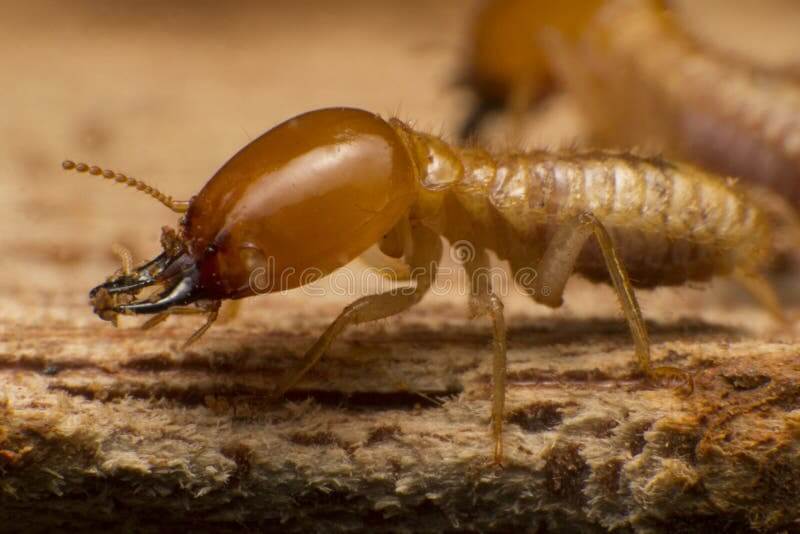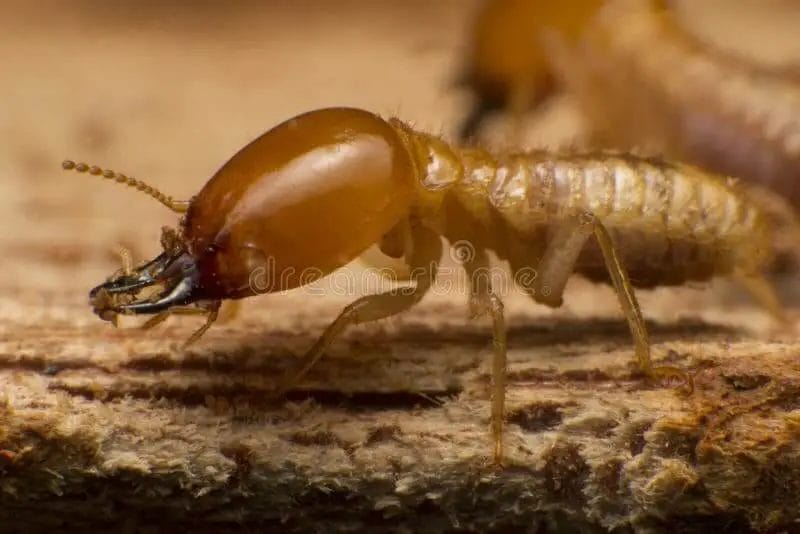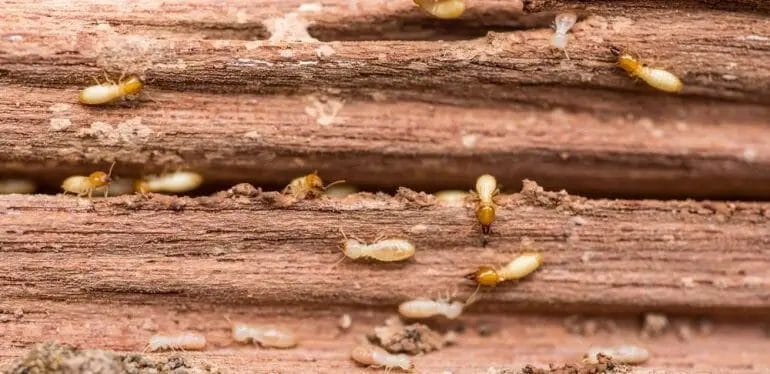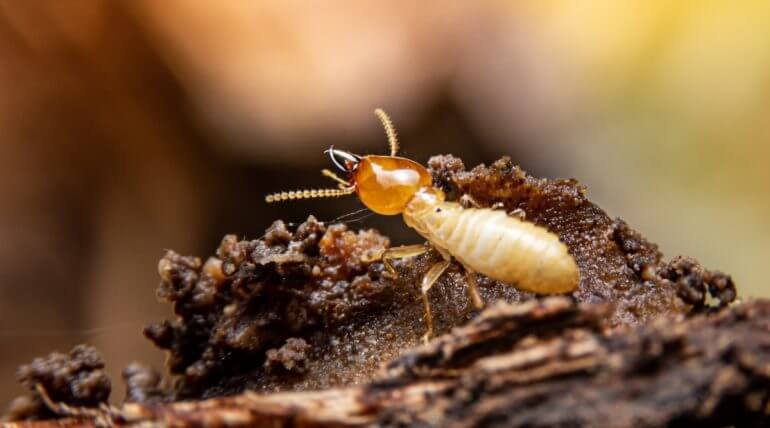Termites, those tiny insects that can cause big damage, have a unique and fascinating way of consuming wood. With their powerful jaws and digestive system, termites break down the cellulose in wood, feeding on it as their primary source of nutrition. Through a process called “symbiosis,” termites rely on bacteria and protozoa in their guts to help them digest and extract nutrients from the wood. This enables termites to efficiently break down and utilize the cellulose, allowing them to thrive and survive in their wood-eating habits.

The Wood Digestion Process of Termites
Termites are fascinating creatures that play a crucial role in the ecosystem by breaking down cellulose-rich materials like wood and recycling them back into the environment. This process is known as wood digestion and is made possible by the unique adaptations and symbiotic relationships that termites have evolved over millions of years.

Termites have a specialized digestive system that allows them to efficiently break down cellulose, the main component of plant cell walls. Unlike humans and other animals, termites cannot produce the enzymes necessary to digest cellulose on their own. Instead, they rely on a symbiotic relationship with microorganisms, such as bacteria and protozoa, that live in their digestive tract.
When termites consume wood, it first enters their foregut, where it is mixed with saliva and mucus. This mixture then passes into the midgut, where the real work of digestion begins. The microorganisms present in the termite’s gut produce a variety of enzymes, including cellulases and hemicellulases, which break down the complex structure of cellulose into simpler sugars.
Once the cellulose has been broken down, the sugars are absorbed by the termite’s gut lining and transported to other parts of their body for energy production. In addition to cellulose, termites can also digest other components of wood, such as lignin and pectin, thanks to the enzymes produced by their gut microorganisms.
Interestingly, not all termites rely solely on gut microorganisms for digestion. Some termite species have developed a unique strategy called “gut farming.” These termites cultivate a specific species of fungi in their colonies, which they feed with wood. The fungi then break down the wood and produce simpler nutrients that the termites can easily digest.
The wood digestion process in termites is highly efficient, allowing them to extract maximum nutrients from wood and sustain their colonies. This ability has made termites both beneficial and destructive, depending on the context. In natural ecosystems, termites contribute to nutrient cycling and soil enrichment. However, when they infest human structures, they can cause significant damage.
In summary, termites have a remarkable wood digestion process that relies on symbiotic relationships with microorganisms or fungi. These partnerships enable termites to break down cellulose and other components of wood into digestible nutrients, allowing them to thrive and play their important ecological role.

Termites’ Feeding Habits: Wood Preferences
In this section, we will explore the feeding habits of termites and their preferences when it comes to consuming wood. Termites are known for their ability to cause extensive damage to wooden structures and can be a major concern for homeowners and property owners.
1. Cellulose as the Main Food Source:
Termites primarily feed on cellulose, which is a complex carbohydrate found in plant material, especially wood. Cellulose serves as the main energy source for termites, providing them with the necessary nutrients to survive and reproduce. However, not all types of wood are equally appealing to termites.
2. Damp Wood vs. Dry Wood:
Termites have different preferences when it comes to the moisture content of wood. Some species of termites are more attracted to damp or decaying wood, while others prefer dry wood. Damp wood can provide termites with a higher moisture content, which they require for survival.
3. Softwood vs. Hardwood:
Termites also exhibit preferences between softwood and hardwood. Softwood, such as pine or cedar, is typically less dense and easier for termites to consume. On the other hand, hardwood, like oak or mahogany, is denser and provides more resistance against termite infestation. However, it is important to note that certain termite species may still attack hardwood if conditions are favorable.
4. Wood Treatments and Termite Resistance:
Wood treatments can play a significant role in deterring termite infestations. Certain types of wood treatments, such as pressure-treated wood or chemical treatments, can make the wood less appealing or even toxic to termites. These treatments create a barrier that can prevent termites from accessing the cellulose in the wood and feeding on it.
5. Other Factors Affecting Wood Preferences:
Aside from the moisture content and type of wood, termites’ feeding habits can also be influenced by other factors, such as the presence of mold or fungi. Some termite species are attracted to wood that has already been colonized by fungi, as the fungi can break down cellulose, making it easier for termites to consume.
Summary:
Termites have specific preferences when it comes to the type and condition of wood they consume. Understanding their feeding habits and wood preferences can help homeowners and property owners take preventive measures to protect their structures from termite infestations. By using termite-resistant wood, implementing appropriate wood treatments, and addressing any moisture issues, it is possible to minimize the risk of termite damage.

Impact of Termite Wood Consumption on Buildings
Termites are small insects that feed on wood and can cause significant damage to buildings. Their ability to consume large amounts of wood can have a detrimental impact on the structural integrity and aesthetics of a building. In this section, we will explore the various ways in which termite wood consumption can affect buildings.
1. Structural Damage
One of the most significant impacts of termite wood consumption is the structural damage they can cause to buildings. Termites feed on the cellulose present in wood, weakening its structure over time. As termites tunnel through wooden structures, they create hollow spaces, compromising the overall strength and stability of the building. This can result in sagging floors, leaning walls, and even collapse in severe cases.
2. Cost of Repairs
Termite damage can lead to expensive repairs for building owners. Once the presence of termites is detected, immediate action must be taken to eliminate the infestation and repair the damage caused. This often involves replacing damaged wood, treating the affected areas, and implementing preventive measures to prevent future infestations. The cost of these repairs can vary depending on the extent of the damage and the size of the building.
3. Aesthetics and Property Value
Termite damage can also have a negative impact on the aesthetics of a building and its property value. As termites consume wood, they leave behind a network of tunnels and galleries, which can mar the appearance of wooden surfaces. This can be particularly problematic for buildings with visible wooden features or structures. Additionally, the presence of termite damage can lower the overall value of a property, as it raises concerns about the structural integrity and potential ongoing infestations.
4. Safety Risks
Termite infestations can pose safety risks to occupants of a building. As the structural integrity of a building is compromised, there is an increased risk of accidents and injuries. Sagging floors, weakened support beams, and falling debris are all potential hazards that can result from extensive termite wood consumption. To ensure the safety of occupants, it is crucial to address termite infestations promptly and mitigate the damage caused.
5. Long-Term Impact
The impact of termite wood consumption on buildings can be long-lasting. If left untreated, termite infestations can continue to spread and cause further damage over time. This can lead to ongoing repair and maintenance costs, as well as potential structural failures. Regular inspections and proactive termite prevention measures are essential in mitigating the long-term impact of termite wood consumption on buildings.
In summary, termite wood consumption can have a significant impact on buildings. From structural damage to costly repairs, compromised aesthetics to safety risks, and long-term consequences, it is crucial to address termite infestations promptly and implement preventive measures to protect buildings from these destructive pests.
Preventing Termite Damage: Effective Wood Treatment Methods
One of the biggest nightmares for homeowners is the damage caused by termites. These tiny pests can wreak havoc on the wooden structures of a property, leading to costly repairs and potential safety hazards. To protect your home from termite damage, it is crucial to implement effective wood treatment methods. In this section, we will explore some of the most effective ways to prevent termite infestation and protect your wooden assets.1. Chemical Treatments
Chemical treatments are one of the primary methods used to prevent termite damage. These treatments involve the application of specially formulated chemicals to the wooden structures vulnerable to termite infestation. The chemicals used for termite treatment are designed to repel or kill termites upon contact, creating a protective barrier. There are two main types of chemical treatments: liquid termiticides and bait systems. Liquid termiticides are applied to the soil around the foundation of the building to create a barrier that termites cannot penetrate. Bait systems, on the other hand, utilize termite baits to attract and eliminate termite colonies. These baits contain substances that are toxic to termites and are strategically placed around the property to lure termites away from the wooden structures.2. Physical Barriers
Physical barriers are another effective method for preventing termite damage. These barriers are installed during the construction phase of a building and are designed to block termite access to the wooden components. Some common types of physical barriers include stainless steel mesh, crushed rock, and sand barriers. Stainless steel mesh is placed in the soil around the foundation of the building to create a barrier that termites cannot penetrate. Crushed rock and sand barriers work by creating a layer of non-wood material that termites cannot pass through. These physical barriers act as a deterrent and prevent termites from reaching the wooden structures, minimizing the risk of infestation.3. Wood Treatments
Wood treatments involve the application of chemicals directly to the wooden structures to make them less appealing and resistant to termites. These treatments can be applied to both new and existing wooden components of a property. The chemicals used in wood treatments are designed to repel termites, making the wood less susceptible to termite damage. There are several types of wood treatments available, including borate treatments and pressure treatments. Borate treatments involve the application of borate-based chemicals to the wood, which penetrate the wood fibers and provide long-term protection against termites. Pressure treatments, on the other hand, involve injecting chemicals into the wood under high pressure, ensuring deep penetration and adequate protection against termites.4. Regular Inspections and Maintenance
Regular inspections and maintenance play a crucial role in preventing termite damage. By conducting routine inspections, you can identify early signs of termite activity and take immediate action to eliminate the infestation. Hiring a professional pest control company to perform regular inspections is highly recommended, as they have the expertise and tools to detect hidden termite colonies. In addition to inspections, regular maintenance of the wooden structures is essential to prevent termite damage. This includes keeping the area around the foundation clear of debris, ensuring proper drainage to prevent moisture buildup, and promptly repairing any cracks or openings in the wooden components. By maintaining a termite-free environment and addressing any vulnerabilities, you can effectively minimize the risk of termite infestation and subsequent damage. In summary, preventing termite damage requires implementing effective wood treatment methods. Chemical treatments, such as liquid termiticides and bait systems, create a protective barrier against termites. Physical barriers, such as stainless steel mesh and crushed rock, block termite access to wooden structures. Wood treatments, including borate treatments and pressure treatments, make wood resistant to termites. Regular inspections and maintenance are also crucial in detecting and preventing termite infestations. By employing these preventative measures, you can safeguard your property from termite damage and ensure the longevity of your wooden assets.Natural Ways to Repel and Control Termites in Wood
Termites can cause significant damage to wooden structures and furniture in homes and businesses. It is important to take proactive measures to repel and control these destructive pests. While there are several chemical pesticides available on the market, many people prefer to use natural methods to protect their wood from termites. In this section, we will explore some effective natural ways to repel and control termites in wood.
1. Orange Oil
Orange oil is derived from orange peels and contains compounds that are toxic to termites. It can be applied directly to the infested wood or used as a preventative measure to repel termites. To use orange oil, dilute it with water and spray it onto the affected areas. The oil penetrates the wood, killing termites on contact and leaving behind a residual scent that repels future infestations.
2. Neem Oil
Neem oil is derived from the seeds of the neem tree and has both insecticidal and insect repellent properties. It disrupts the feeding and molting process of termites, ultimately leading to their demise. To use neem oil, mix it with water and spray it onto the infested wood. Repeat this process regularly to prevent termites from returning.
3. Vinegar
Vinegar is a versatile household ingredient that can be used to repel termites. Its strong odor and acidic properties make it inhospitable for these pests. To use vinegar, mix equal parts of vinegar and water in a spray bottle and apply it directly to the infested areas. This will not only repel termites but also help eliminate any existing infestation.
4. Borax
Borax, also known as sodium borate, is a natural mineral compound that is toxic to termites. It acts as a stomach poison, causing the pests to die upon ingestion. To use borax, mix it with warm water and apply the solution to the infested wood using a brush or spray bottle. Borax can also be used as a preventive measure by treating the wood before it becomes infested.
5. Diatomaceous Earth
Diatomaceous earth is a natural sedimentary rock powder that is safe for humans but deadly to termites. Its microscopic razor-sharp particles penetrate the exoskeleton of termites, causing them to dehydrate and die. To use diatomaceous earth, sprinkle a thin layer on and around the infested wood. Reapply as needed to maintain its effectiveness.
6. Wet Cardboard Trap
A wet cardboard trap is an effective way to lure and eliminate termites. Termites are attracted to the cellulose in the cardboard and will infest it. Once they have gathered in the cardboard trap, remove it and burn it or soak it in water to kill the termites. This method can help reduce the termite population in and around your property.
7. Maintain a Dry Environment
Termites thrive in moist environments, so by maintaining a dry environment, you can discourage their infestation. Ensure proper ventilation in your home or business to prevent condensation. Fix any leaks or water damage promptly, and use a dehumidifier in areas prone to excess moisture. By reducing moisture levels, you make the environment less conducive for termites.
In summary, termites can cause significant damage to wood, but there are natural ways to repel and control these pests. Using orange oil, neem oil, vinegar, borax, diatomaceous earth, wet cardboard traps, and maintaining a dry environment can help protect your wood from termite infestations. It is important to regularly inspect and treat your wooden structures to ensure they remain termite-free.
FAQs
How do termites eat wood?
Termites have special enzymes in their gut that allow them to break down cellulose, the main component of wood. They use bacteria and protozoa in their digestive system to help them digest cellulose and extract nutrients from the wood.
Conclusion:
In conclusion, termites have adapted specialized mechanisms to consume wood efficiently. Through a combination of digestive enzymes and gut symbionts, they are able to break down the cellulose present in wood. This process allows them to extract essential nutrients and energy from their primary food source. Termites also construct intricate tunnel networks that enable them to access and exploit wood resources. Their ability to digest wood is a remarkable feat of evolution, showcasing their unique niche in the ecosystem. Understanding how termites eat wood is crucial for effective pest control and the preservation of wooden structures.